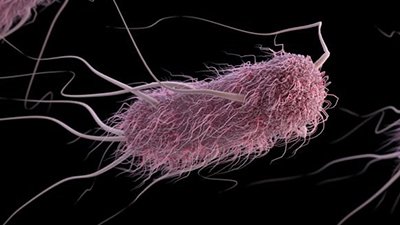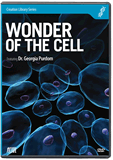The Amazing Cell
Evidence for Creation and Against Evolution!
As a microbiologist, the bacterial flagellum has always fascinated me.
As a microbiologist, the bacterial flagellum has always fascinated me.
The flagellum is a corkscrew-shaped, hair-like appendage attached to the cell surface, which acts like a propeller, allowing the bacterium to swim. The most interesting aspect of the flagellum is that it is attached to—and rotated by—a tiny, electrical motor made of different kinds of protein.
Like an electrical motor, the flagellum contains a rod (drive shaft), a hook (universal joint), L and P rings (bushings/bearings), S and M rings (rotor), and a C ring and stud (stator). The flagellar filament (propeller) is attached to the flagellar motor via the hook. To function completely, the flagellum requires over 40 different proteins. The electrical power for driving the motor is supplied by the voltage difference developed across the cell (plasma) membrane.
In 1996, Dr. Michael J. Behe, a professor of biochemistry at Lehigh University (and an evolutionist), published a challenging book to classical Darwinian evolution entitled “Darwin’s Black Box.” In this book he uses the flagellum to introduce the concept of “irreducible complexity.” If a structure is so complex that all of its parts must initially be present in a suitably functioning manner, it is said to be irreducibly complex. All the parts of a bacterial flagellum must have been present from the start in order to function at all.
According to evolutionary theory, any component which doesn’t offer an advantage to an organism, i.e. doesn’t function, will be lost or discarded. How such a structure could have evolved in a gradual, step-by-step process as required by classical Darwinian evolution is an insurmountable obstacle to evolutionists. How a flagellum is used, however, adds an additional level of complexity to the picture.
Some bacteria have a single flagellum located at the end of a rod-shaped cell. To move in an opposite direction, a bacterium simply changes the direction of rotation of the flagellum. Other bacteria have a flagellum at both ends of the cell and use one flagellum for going in one direction and the other for going in the opposite direction. A third group of bacteria has many flagella surrounding the cell. These flagella wrap themselves together in a helical bundle at one end of the cell and rotate in unison to move the cell in one direction. If the cell wants to change direction, the flagella unwrap themselves, move to the opposite end of the cell, reform the bundle, and again rotate in a coordinated fashion.
The structural complexity and finely tuned coordination of the bacterial flagellum attests to the work of a master engineer who designed and created the flagellum to function in a wonderfully intricate manner.
is a microbiologist who does not apologize for his belief in the literal Genesis account of Creation. A former theistic evolutionist, Dr. Eirich in 1983 became convinced of the fallacy of the evolutionary theory. He is an avid reader of AIG’s Creation magazine and Technical Journal.The following brief article by Dr. Eirich provides ample evidence that the incredible complexity of the flagellum in cells provides overwhelming evidence of a Master Designer.
Recommended Resources

Answers in Genesis is an apologetics ministry, dedicated to helping Christians defend their faith and proclaim the good news of Jesus Christ.
- Customer Service 800.778.3390
- © 2025 Answers in Genesis








